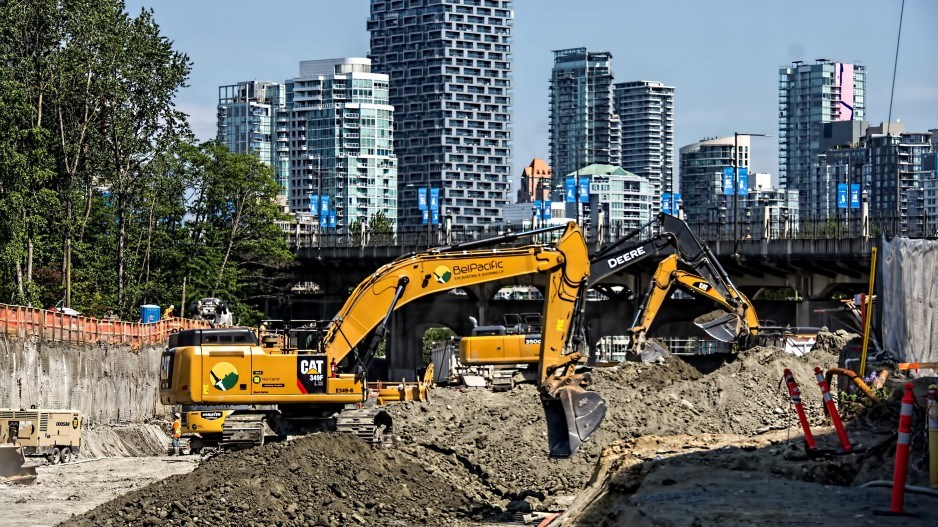Resolving B.C.’s housing affordability crisis in B.C. has been focused on increasing supply, but some industry experts say the government needs to examine how housing is financed.
Community amenity contributions (CACs) and development cost charges (DCCs) are among the many government fees built into the construction process. They are levied by all levels of government and are designed to offset the density that is created from building new homes.
The impact of these costs, coupled with long approval cycles, is increasing the risk, uncertainty and potential for projects to be shelved, according to Ron Rapp, CEO of the Homebuilders Association Vancouver.
“In most cases CACs are not subject to any provincial guideline or regulation. They’re effectively negotiated, and in some cases mandated. In some cases, municipalities have attributed CAC bylaws, and they have turned that into what effectively is a tax on a per-door basis,” said Rapp.
“Because there’s no framework around CACs, it’s all over the ice and, as a consequence, you can see CACs that are a few thousand to tens of thousands of dollars.”
Government fees imposed on a project can range from those that cover infrastructure-related needs (DCCs and development cost levies), community contributions that will offset density (CACs), a federal goods and service tax (GST), building and development permits, property transfer taxes and the speculation and vacancy tax.
In Vancouver, there is also the additional empty homes tax and a public art fee, according to a February 2023 Urban Development Institute, Pacific Region report.
The total cost of government fees represents 32.72 per cent of rent that the end-user pays in a typical wood-frame, purpose-built rental development in Vancouver.
Municipal fees account for the majority of this total at 44.27 per cent; federal and provincial fees account for 28.39 and 24.15 per cent, respectively. The remaining 3.18 per cent is attributed to regional fees. For a typical wood-frame condo development in Vancouver, the fees represent 29.25 per cent of the unit’s final purchase price and are three times higher in Vancouver compared with Saanich, which costs end-users between 8.66 per cent and 10.32 per cent of the unit’s value.
The purpose-built rental market is especially sensitive to government fees because developers cannot bank equity from presales. Also, they can only start charging rent once units are occupied, and those rents are dictated by market conditions, not the additional costs builders face.
“People don’t realize it’s an entire economic ecosystem, and you can’t just keep adding costs, and then not have some sort of tax break or tax incentive,” said Anne McMullin, president and CEO of UDI, a non-profit industry association of residential, commercial and industrial builders. “We’ve got brand new building codes. So, there’s more requirements for seismic upgrades, there’s more requirements for sustainability and all these things at cost. But there’s no offset system in the building of new homes,”
She added that government fees raise costs and risks for builders.
On the other hand, they help bankroll important infrastructure and public service projects that are needed as a region’s population grows.
In the past 10 years, CACs and development cost levies (DCLs) helped secure 3,200 social housing units, 870 licensed child-care spaces and 37 new or expanded cultural, recreational, library and social facilities across Vancouver, according to a statement to Glacier Media (TSX:GVC) from Chris Robertson, director of city-wide and regional planning with the City of Vancouver.
“CACs and DCLs are critical growth-related funding sources. With new development comes the need to provide additional amenities and infrastructure to support a growing population and employment base,” said Robertson in the statement.
“The development industry has long been supportive of the ‘financing growth principle’ – growth pays for growth. This means that development contributions help fund amenities and infrastructure, which limits the cost of growth being funded through taxes and user fees.”
According to Robertson, 50 per cent of the city’s 2023-26 capital plan is funded through development contributions.
“In many ways, DCCs and CACs have become a mechanism by which to fund infrastructure on the part of municipalities without having to resort to a broad base increase in taxes, because you’re basically pinning it on new construction,” said Rapp. “At the same time, looking at it through the lens of affordability, it’s making a significant contribution to what a purchaser is paying for on the bottom line.”
When asked through email what the impact government fees have on the construction industry, Robertson said that there is no negative impact on the supply of new housing.
“There is no evidence that CACs are causing housing prices to rise or that CAC costs are ‘passed on’ to homebuyers. The market sets the price and analysis shows that two projects; one built with a CAC payment, and the other without had consistent asking prices.”
Rapp said that any effort to streamline or add a greater degree of certainty to how these fees are imposed would be “very helpful.”
The Development Finance Review Committee, formed by B.C.’s Ministry of Municipal Affairs as an advisory committee to provide advice and feedback, is providing confidential advice and feedback to Ministry of Housing staff on the development finance framework.
“This process is informing one of the development approvals process review priorities to make the development approvals process more effective and efficient,” the Ministry of Housing said in a statement to Glacier Media.
The statement described the work as confidential and that the public will be informed of any updates as the information becomes available.




